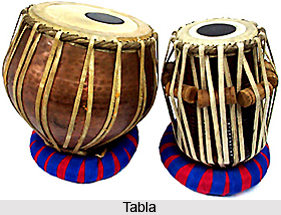 Tala in Indian Classical Music refers to the measurement of time in music. The tala or time measure is more difficult to master than the melody or Raaga itself. But since the Raaga must be sung strictly in tala, the technique of tala must be mastered. All talas are fixed and set, and the musician has to learn them, and then to adhere strictly to rules governing them. The talas are not usually written down for the musician to follow but they have to be learnt. Not that the tala is written down for the musician to follow, as in the time measures of western music, but the Indian learns them off by rote, and then the rhythm becomes such a part of him that he just cannot get out of tala.
Tala in Indian Classical Music refers to the measurement of time in music. The tala or time measure is more difficult to master than the melody or Raaga itself. But since the Raaga must be sung strictly in tala, the technique of tala must be mastered. All talas are fixed and set, and the musician has to learn them, and then to adhere strictly to rules governing them. The talas are not usually written down for the musician to follow but they have to be learnt. Not that the tala is written down for the musician to follow, as in the time measures of western music, but the Indian learns them off by rote, and then the rhythm becomes such a part of him that he just cannot get out of tala.
The duration of every beat should be of equal length. The music is divided into measures which consist of a number of syllables or "Matras" and with stress falling at regular intervals. There are three such stress beats, the strong, the medium and the weak. Of these the strong accent or the "Sam" is the most important thoka accentuated by the Indian drums, called the Tablas. These tablas and their player, the Tabalchi, constitute a very vital part of Indian music. No concert can take place, either vocal or instrumental, without these tablas, for it is these instruments that guide the artist to keep proper time. There are two tablas, one manipulated by the right hand and the other by the left, both being exactly tuned to a pitch selected by the performer. The tabalchi is thus the principal accompanist in any concert of Indian music. The singer must moderate his songs according to the tabla beats.
The tables are guided by the system of Bols which indicates to the drummer how the thokas are to be beaten on his instrument. Each Bol connotes a particular thoka. Two of the most important thokas used in Indian Classical Music are the Khali and the Sam. On the khali one drum is, absolutely silent and the tabalchi indicates the beat usually by the wave of the hand. If, therefore, the singer in all this intricate business of preserving both the raga and the time should miss count of the beats, this khali is a very sure guide to him and brings him back to the Sam, which comes immediately after it. The sam is by far the most alluring thoka of any tala. It is the culminating point, the climax as it were of the whole song.
The tala runs on a particular tempo or speed. Broadly speaking, there are three speeds- slow, medium and fast. The artist begins his song in a deliberate slow tempo, and gradually works up to the fast. This fast is sometimes so fast, and is accelerated to such a pitch, that there is no like of it in the western tempo.
The time measure is thus the most important part of Indian Music. The whole balance of the music is maintained by these time variations, and sometimes they form the sole accompaniment for the singer.




















